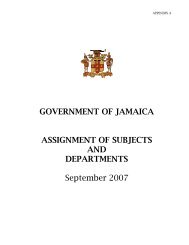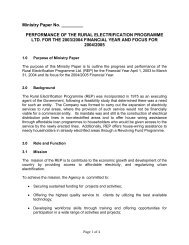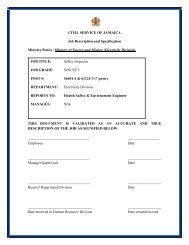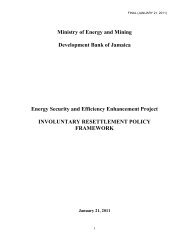Jamaica Biofuels Report - Ministry of Energy
Jamaica Biofuels Report - Ministry of Energy
Jamaica Biofuels Report - Ministry of Energy
Create successful ePaper yourself
Turn your PDF publications into a flip-book with our unique Google optimized e-Paper software.
Additional assumptions involve extending the cane-harvesting season to 270 days per year, inorder to take better advantage <strong>of</strong> processing capacity and reduce the time during which themill will require supplemental fuel to continue generating firm electric power for export. Sincefermentation is less exacting than sugar production in terms <strong>of</strong> the time intervals between peaksugar conditions and cane harvesting and also before crushing, and because concentrated canejuice can be stored and techniques used to promote early ripening, moving to a 270 daycrushing season seems possible. However, this would need to be explored in more depth duringa feasibility study. The analysis also assumes that, unlike the proposed arrangement at Frome,supplemental fuel will be in the form <strong>of</strong> 23,000 tonnes per year <strong>of</strong> cane tops and leavesdelivered with the cane to increase the production <strong>of</strong> bagasse, which can be stored to fuel <strong>of</strong>fseasonpower generation.Specific features <strong>of</strong> the pilot appear below, and the spreadsheet at the end <strong>of</strong> this sectionoutlines in detail the pr<strong>of</strong>orma statements for the Duckenfield pilot project. As in the case <strong>of</strong>the Frome example, the authors feel the assumptions are realistic, but the IRR is affected by anumber <strong>of</strong> variables, some <strong>of</strong> which are beyond the mill’s control and should be studied inmore detail. Several crucial external variables are: (1) the price <strong>of</strong> sugar, assumed here toreturn to historic levels from its current highs; (2) the value <strong>of</strong> ethanol, which is tied closely topetroleum; and (4) The price at which <strong>Jamaica</strong>’s Utility Company is willing to purchase the mill’sexcess electricity (feed-in tariff).Added ComponentInvestment (US$)Distillery $4,011,593Boiler plant $3,947,051Steam turbine $2,128,594Anaerobic digestion system $1,197,110Composting system $74,471Electrical system $3,525,897Construction and commissioning $2,168,834Total Investment $17,053,549Sugar CaneTonnes/yJones Estate (1,300 ha; 87 tonnes/ha) 113,100Golden Estate (2,500 ha; 85 tonnes/ha) 212,500Small Farmers (600 ha; 74 tonnes/ha) 44,400Total clean cane (tonnes/yr) 370,000Leaves and tops 23,000Total "trashy" cane (tonnes/yr) 393,000Ethanol RefineryLiters/yEthanol production 33,750,00093










